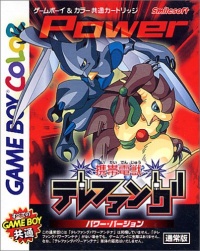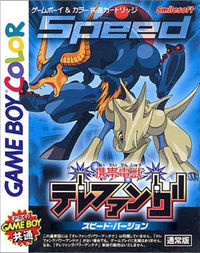Telefang 1
| Keitai Denjū Telefang | |
 
| |
| Developer(s) | Smilesoft |
|---|---|
| Publisher(s) | Natsume |
| Designer(s) | Takagi Toushi |
| Release date | 3 November 2000 |
| Genre | Console role-playing game |
| Platform | [[wikipedia:Game Boy Color|Game Boy Color]] |
- For the second version of Keitai Denjū Telefang, see Telefang 2.
Keitai Denjū Telefang (Japanese: 携帯電獣テレファング; Romaji: Keitai Denjyuu Terefangu) is a video game for Game Boy Color released by Smilesoft in Japan. It is available in two versions, namely Power version and Speed version.
Plot
In the year 2020 it became possible to travel to the "electric monster world" using special portable telephones. Making friends and sharing telephone numbers with the "electric monsters" became popular among humans.
Our protagonist, Shigeki, is one such person. Although he originally arrived in the electric monster world on accident, he became determined to travel the world with his new electric monster companion, and make more new friends while he was there.
Characters
Humans
- Template:Nihongo - The protagonist of the game, he is an average boy who loves baseball. He is transported to the Denjū world when he loses a ball near a strange tree. In Diamond/Jade, he is called Bek.
- Template:Nihongo - A child genius who wants to learn more about the Denjū world. He accidentally gets transported there along with Shigeki. In Diamond/Jade, he is called Sungki. In Telefang 2, Matsukiyo runs a laboratory in the human world where he pays the player for information on certain Denjū.
- Template:Nihongo - She is a strong-willed girl who is described as a childhood friend of Shigeki, but teases him about never having been to the Denjū world. Her partner is the weasel-like Denjū Suguri Template:Nihongo. In Diamond/Jade, she is called Miyor.
- Template:Nihongo - A mysterious boy encountered during Shigeki's travels, his purpose in the Denjū world is unclear. In the Power Version, his partner is Template:Nihongo, while in Speed Version it is Template:Nihongo. In Diamond/Jade, he is called Boundary.
- Template:Nihongo - The owner of the Sanaeba pharmaceutical company, who were the first to discover the Denjū world. After the discovery they began to branch their business into other areas, and they control the human-to-Denjū world gates. While they allow children to come and go freely, adults must pay a fee. Sanaeba seems to have his name attached to many of the problems which have cropped up in the Denjū world, and is apparently manipulating Denjū for some unknown reason.
- Nerikara - A member of Sanaeba who tries to become prime minister of the Denjū world. He tries to get people to vote for him by setting up a curry store.
- Tabasuko - A enemy of Shigeki in the Denjū world.
Denjū
- Template:Nihongo - A strong Denjū with a hot-tempered personality. It is assigned by Musa as Shigeki's first partner in the Power Version.
- Template:Nihongo - A swift Denjū with a faithful personality. It is assigned by Musa as Shigeki's first partner in the Speed Version.
- Template:Nihongo - An old, turtle-like Denjū who is the first to greet Shigeki and Matsukiyo after they're dropped into the Denjū world. He asks for their help with various problems that his world is suffering, and introduces Shigeki to his first partner. Musa's phone number is one of the secret ones which must be manually inputted, and he cannot otherwise be obtained as a partner during normal gameplay.
- Anjiosi/Dimunosi - Partners of Kai/Boundary (Anjiosi in Power Version and Dimunosi in Speed Version).
The name
Keitai means mobile in Japanese, while Den means electric, jū means monster, and Telefang is a English word in Katakana to mean something like Telephone Fangs (Fangs as in monsters).[1]
Version Differences
The two versions, Power and Speed, have some differences:
- In Power version, the starter partner you will have is Krypto but in Speed version it is Fangs.
- There are different Denjū appearances in the two versions.
- There are some colour differences in the two such as the colour of the D-Shoot menu.
- In Paparuna Lake, the order of houses one is required to enter to solve the puzzle is different in Power version than that in Speed version.
Sequel
- Main article: Telefang 2
- Main article: Differences between Telefang 1 and Telefang 2
Smilesoft released a sequel to Keitai Denjū Telefang for the Game Boy Advance, with new Denjū appearances and a slightly different style of battle, where the player can intervene in a middle of a battle to use items on the Denjū. Move types were also introduced.
The sprites were also redrawn, and had better graphics and music.
Bootleg
- Main article: Pokémon Diamond and Jade
Keitai Denjū Telefang was originally only available in Japanese. However, pirates in China bootlegged it under the name of Pokémon Diamond and Pokémon Jade. [1] Their attempt was not very good, as the English is poor with some profanities included.
The sprites and maps remain the same, just that it is English. The ability to name the character or the Denjū was also not present, and the game would also not load a save properly.
See also
References
- ↑ Jump up to: 1.0 1.1 http://en.wikipedia.org/wiki/Keitai_Denjuu_Telefang. Accessed on 13 January 2008.